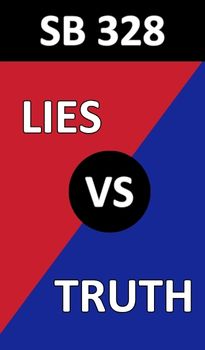* Chicago Reader…
When James McIntyre advocates for queer kids facing abuse and neglect in the state’s foster care system, he draws on painful personal experience of his own time in the system—and the abuse he endured. McIntyre was only three years old when his parents’ drug use and neglect forced Illinois child protection authorities to place him and his four siblings in foster care. A couple eventually adopted him and two siblings years later, but that home wasn’t the solace he was promised.
He tells the Reader that after he turned seven years old, his adoptive mother would beat and starve him. And her biological son raped him for years. After escaping that home by feigning mental illness, McIntrye says he was shuffled between foster homes until he turned 21 and aged out of the system.
Amid all the trauma and abuse, McIntyre says being gay made his circumstances even worse. From the state’s Department of Children and Family Services, from foster agencies, and from foster families themselves, he says he was routinely told to hide the fact that he was gay. “Being gay was seen as a safety risk,” he says. “And so instead, they force the gay kids in the closet and say, ‘We don’t have any gay kids.’ Because then it would be seen as an unsafe situation to acknowledge that one of their kids is gay.”
In February, the state’s auditor general reported that the Illinois DCFS failed in myriad ways to adequately care for LBGTQ+ kids. The report found “a lack of reliable and consistent information regarding LGBTQ youth in the care of the department'’ and “a lack of monitoring and oversight of private agency compliance” with its policies and procedures related to LGBTQ+ youth. […]
The 16 recommendations in the auditor’s report mostly target the agency’s lack of enforcement and oversight of its policies related to LGBTQ+ youth, known as Appendix K. But the report also states that the agency has no formal process for identifying LGBTQ+ youth, with housing placement practices being similarly opaque. […]
In a statement provided to the Reader, the agency said that it has taken “aggressive measures to improve the services and care provided to LGBTQI+ youth since the time period covered by this audit.” A representative for the department says the audit additionally doesn’t reflect the current state of the department, as it uses data mostly from 2017 and 2018.
* OK, but have things improved since then? I asked the Illinois ACLU’s Ed Yohnka that question…
Generally I would say that the experiences of most LGBTQ youth in care have not significantly improved over the time we have been investigating their experiences – since 2017. We acknowledge DCFS has done some work to address this population’s needs since the time of the audit, but that work has not yet translated into any better experiences for young people in state care.
*** UPDATE *** DCFS…
The Department of Children and Family Services, under its current leadership, has taken aggressive measures to improve the services and care provided to LGBTQI+ youth since the time period covered by this audit. The progress is outlined in our audit responses, and DCFS continues to work diligently to provide resources and guidance to its staff and external partners to ensure that we meet the needs of this vulnerable population.
Background…
As part of our commitment to providing services across the state, DCFS has created a new hiring plan and is working to fill every vacancy as quickly as possible. The newly created position of Chief for LGBTQI+ Services has recently been filled.
This audit was conducted in 2019 using data primarily from 2017 and 2018.
Recent efforts include maintaining and expanding a list of providers, agencies, and organizations across the state that are available to meet the needs of LGBTQI+ youth. These providers include affirming therapists, LGBTQI+ organizations and agencies, and health care professionals that provide gender-affirming hormone therapy.
In June 2020, the Illinois Department of Children and Family Services Clinical Division and Office of Diversity, Equity and Inclusion began a coordinated effort to expand programmatic support for LGBTQI+ youth in care.
The Clinical Division completes staffing and consultations, while providing clinical recommendations regarding interventions, resources, and resource linkages for the youth in care.
The DEI LGBTQI+ Services team is addressing competency training needs and recruitment of affirming caregivers, continuing to build resources, and investigating all claims of discrimination as it relates to our LGBTQI+ youth and their families.
The Clinical Division and DEI are working closely together to ensure that DCFS is following best practices for LGBTQI+ youth and their families.
3 Comments  
|
* Michael Hawthorne…
Nearly every major industrial source of ethylene oxide makes it relatively easy for Americans to know how much of the cancer-causing gas drifts into surrounding communities.
The only outliers are two Illinois-based companies that for years have failed to report emissions to the Toxics Release Inventory, a Tribune review of federal records found.
A Medline Industries plant in north suburban Waukegan last appeared in the inventory during the mid-2000s, even though the U.S. Environmental Protection Agency later determined the facility has been responsible for some of the nation’s highest cancer risks from air pollution.
Oak Brook-based Sterigenics stopped filing annual reports with the EPA in 2018, the same year neighbors and political leaders fought to shut down one of the company’s sterilization plants in west suburban Willowbrook.
Sheesh.
*** UPDATE *** Jesse Greenberg at Medline…
Illinois has the toughest ethylene oxide restrictions in the country. Our emissions data is public and available on the IEPA website for anyone to access at any time. Our Waukegan facility didn’t submit reports to the Toxic Release Inventory because federal rules didn’t require it. The USEPA recently changed that reporting requirement, which we welcome, and as a result the company will file reports moving forward.
5 Comments  
|
* Last week, we discussed Republican gubernatorial candidate Gary Rabine’s position that the state ought to opt out of a federal unemployment program…
Gary Rabine, a candidate for Governor, is calling for Illinois to join the list of a growing number of states opting out of the federal unemployment benefits.
“Small businesses have suffered long enough and now with their inability to find workers to fill their openings, they will suffer longer,” Rabine said. “It is very important that we stop the unemployment stimulus now and get our kids back to school in Illinois.”
* Sun-Times…
Right now, Illinoisans collecting unemployment insurance receive an extra $300 a week from the federal government, intended to help them through the pandemic. Individual governors can opt their states out of that benefit. So far, 18 Republican governors have announced they will not allow their citizens to receive additional money in their unemployment checks. […]
Rival GOP gubernatorial candidate Darren Bailey joined Rabine in calling for Illinois to opt out of the unemployment benefits.
“The government over-incentivizes healthy people to stay home which closes businesses and destroys local economies,” the state senator and farmer from downstate Xenia said. “For the last year, I have been standing up for hardworking Illinoisans and advocating to reopen our state and get people back to work.”
An aside…
Bailey, his wife and the family farm have received more than $2.3 million in federal agricultural subsidies, according to data compiled by the Environmental Working Group.
* Gov. Pritzker was asked about this topic yesterday…
There are a number of reasons that people are collecting unemployment at the moment and why it’s important for them to continue to collect that unemployment. Some people, it isn’t just, I know there’s some talk among Republicans that somehow the people who are collecting it are lazy or they don’t want to work because, gee, they’re getting an extra $300.
The reality is there are many people who have children at home that they still need to take care of because of the circumstances of the pandemic, took them into their circumstances as well where people are afraid to go back to work and they’re staying out of the workforce, or at least staying away from taking a new job.
And these are people who have, those are legitimate reasons that people might remain on unemployment. It’s a temporary time period in which receiving those benefits. But we are slowly but surely, our economy is improving, we are seeing people getting hired. We had roughly about 93,000 people who were hired in the first quarter of the year. So we’ve made a lot of progress, and I don’t want to pull the rug out from under people that have certainly legitimate reasons for remaining on unemployment.
* Back to the Sun-Times…
But Rabine said that only “a paltry 266,000 jobs” were added nationally in April, which he says “suggests the federal unemployment benefits are keeping workers out of the workplace.”
…Adding… Politifact…
“The No. 1 reason now that people aren’t going back to work is fear, or if they can’t find childcare, or schools are still closed,” [Commerce Secretary Gina Raimondo] said May 9.
Raimondo’s office pointed to an experimental government survey that asks people why they aren’t working. It’s called the Household Pulse Survey and it’s larger in scope than the readings that the Labor Department uses to gauge the unemployment rate.
In the last half of April, an estimated 6.7 million said they were caring for children not in school or day care. Another 4.2 million said they were “concerned about getting or spreading the coronavirus.” Those numbers don’t map readily to the standard job reports, but they do give a sense of the scale of these factors.
Raimondo said the pandemic was particularly hard on women. At the trough of the pandemic downturn, the unemployment rate for women was 16.1%, nearly three points higher than men. The virus cratered the hospitality industry, a sector where many women work, and it upended day care and schooling, making it harder for them to return to work.
Stefania Albanesi, professor of economics at the University of Pittsburgh, said work schedules in hotels and restaurants can be “unpredictable and non-conventional, so childcare challenges may be particularly severe for mothers when considering those openings.”
Government numbers show that having kids makes a difference in labor force participation, and it matters more for women than men. Labor force participation is still down for both men and women compared with January 2020, but women are coming back into the workforce more slowly. Women with young kids under age 6 got back into the workforce at half the pace of men over that period; among women with school-age children, it’s one-third.
61 Comments  
|
* Brenden Moore…
The Supreme Court announced Monday that it would hear a case from Mississippi challenging Roe v. Wade, the landmark 1973 decision that established a constitutional right to an abortion. Regardless of that outcome, abortion access will likely continue uninterrupted in Illinois due to a series of laws enacted in recent years in anticipation of a federal rollback.
“The Reproductive Health Act does protect a person’s right to make the decision about a pregnancy and while I can’t predict what the Supreme Court would say, it would be our expectation that the Reproductive Health Act would still provide protections here in Illinois,” said Brigid Leahy, senior director of public policy at Planned Parenthood Illinois. […]
“One of the reasons Roe v. Wade needs reviewed, is even proponents of abortion recognize it’s not a well-written decision,” [Bishop Thomas Paprocki of the Diocese of Springfield] said. “The court said (at the time) that we need not resolve the difficult question of when life begins, but that is the question. They sidestepped the question and said they’re just not going to answer it.”
Because of that, he said, it leaves the possibility of regulation open, such as when a fetus is viable. That is widely accepted as during the third trimester, though in practice it has usually been interpreted to allow abortion at any point in the pregnancy.
“Where do you draw the line?” Paprocki said. “The Catholic Church would argue conception (is where to draw it), but even 15 weeks would be an improvement on what we currently have.”
The RHA was passed with the possibility in mind that the Supreme Court would eventually invalidate Roe v. Wade.
* AP…
The case is an appeal from Mississippi in which the state is asking to be allowed to ban most abortions at the 15th week of pregnancy. The state is not asking the court to overrule Roe v. Wade, or later cases that reaffirmed it.
But many supporters of abortion rights are alarmed and many opponents of abortion are elated that the justices could undermine their earlier abortion rulings. If the court upholds Mississippi’s law, it would be its first ratification of an abortion ban before the point of viability, when a fetus can survive outside the womb. Such a ruling could lay the groundwork for allowing even more restrictions on abortion. That includes state bans on abortion once a fetal heartbeat is detected, as early as six weeks.
If Mississippi wins, it gets to enforce its 15-week ban, which lower courts have so far prohibited. In addition, other conservative states would certainly look to copy Mississippi’s law. A decision that states can limit previability abortions would also embolden states to pass more restrictions, which some states have already done and which are already wrapped up in legal challenges. Challenges to those limits would continue.
That said, the immediate practical impact of a win for Mississippi could be muted. That’s because more than 90% of abortions take place in the first 13 weeks of pregnancy, according to the U.S. Centers for Disease Control and Prevention.
* Forbes…
California, Connecticut, Delaware, Hawaii, Illinois, Maine, Maryland, Nevada, New York, Oregon, Rhode Island, Vermont and Washington have all enacted state laws that explicitly protect the right to an abortion, which will remain in effect in the event that Roe is overturned.
* The Southern…
State Rep. Patrick Windhorst, R-Metropolis, was encouraged to see the U.S. Supreme Court take up the appeal.
“I think the Mississippi law should be allowed to stand,” he said, adding that we will know more once the case is heard.
Windhorst would be like to see the court overturn 50-year-old Roe v. Wade decision and 30-year-old Casey decision that gave and affirmed a woman’s right to seek an abortion.
He has sponsored legislation in the past in Illinois to limit abortions to 20 weeks except in the case of serious health issues of the mother.
“If the court was to overturn Roe v. Wade, it would leave the issue up to the states to determine what freedoms or restrictions to apply to abortion,” Windhorst said. “If the court were to uphold the Mississippi statute, my colleagues and I would look at whether some similar legislation could pass in Illinois.”
…Adding… Planned Parenthood Illinois Action…
We are disappointed, but not surprised that the Supreme Court announced it will review Mississippi’s 15-week abortion ban, which is a direct challenge to Roe v. Wade. With the conservative-majority Supreme Court, anti-abortion legislatures and governors have become even bolder in their attacks on essential health care.
Illinois passed the Reproductive Health Act in 2019, which recognizes the full range of reproductive health care as a fundamental right and ensures abortion will remain legal in our state even if Roe v. Wade is overturned. While we are grateful for this additional protection, it does not safeguard our residents from all threats to our reproductive rights.
Importantly, Illinois also serves as a safe haven for surrounding states, many of which have increasingly restrictive laws that create medically unnecessary barriers for people seeking abortions and other essential health care. If the Supreme Court allows the Mississippi abortion ban to stand, it would put reproductive health care in jeopardy nationwide. And it would create inequity for abortion care, making where you live and how much money you make determine what health care you can access. We will never stop our fight to help everyone have access to the essential health care they need and deserve.
* Related…
* Pritzker addresses Illinois abortion rights as U.S. Supreme Court to hear Roe v. Wade challenge
22 Comments  
|
* The governor held a bill-signing event today, but the questions afterward were mostly about the state’s mask mandate. Here are some excerpts of his answers…
We’re working on making changes to our mask mandate in the state to meet the CDC’s new masking guidance that they gave late last week. So we’ll be announcing those changes shortly, it just takes a little bit of time to work through. […]
I do think that the CDC guidelines are good ones and that we will follow them here in the state. […]
One of the reasons that the CDC issued the rules as they did was the recognition that studies have now been done showing that if you’re vaccinated, you’re protected. If you’re unvaccinated you are not protected. So I encourage people who are unvaccinated still to wear their masks, but to go get vaccinated because I think we all want to get past this, we all would like to take off our masks. But we do need those who are unvaccinated to go get a vaccine and they can do that right now, today, it is available to them. […]
That’s going to be up to private businesses and individuals if they want to carry something like that [vax ID] with them […]
We are relying on people to do the right thing, we are relying upon people to recognize that they don’t want to go infect other unvaccinated people and they don’t themselves want to get sick and so it’s important for people to protect themselves and I think there’s real motivation for people to go get that. […]
We’re not going to stop people and, you know, start checking a vaccine passport as part of some state mandate. […]
I think we’re, as fast as we can, we’re trying to make the changes. As you know, we have a disaster proclamation that needs to be altered. There is a JCAR rule that needs to be rescinded. There’s just a variety of things. It’s been a complicated 14-15-16 months of putting in place a mask mandate and making sure that people are following it, and now obviously we’re working on unwinding it in an appropriate fashion. […]
Well, I was pretty clear, we’re going to follow the CDC guidelines. So if you can read the CDC guidelines, you know what we will be doing in the state of Illinois. I said that last week, I think you were actually at one of the press conferences that I gave that answer in.
I was told this morning by the governor’s office that a new executive order will be ready soon.
* Meanwhile, here’s Natalie Pierre at the State Journal-Register…
Beginning Tuesday, Walmart and Sam’s Club will no longer require vaccinated shoppers and employees to wear masks in stores outside of municipalities that require it, the retailer announced Friday. […]
The memo — which says employees will get a $75 bonus for providing proof they are vaccinated — does not detail a method for ensuring customers without masks are fully vaccinated.
Beginning Monday, masks will also be optional at Starbucks for those who are vaccinated, according to the coffeehouse chain’s website, which notes that its updated mask policy applies to all locations, “unless local regulations require them by law.”
Meijer, Target, CVS and Walgreens are among the stores that, following the latest CDC guidelines, have stated they will continue to require all customers to wear masks for now.
…Adding… BND…
While people who are fully vaccinated against COVID-19 won’t be required to wear masks in many settings, updated federal guidance recommends that masks and social distancing still be required in schools for the rest of the school year.
The Centers for Disease Control and Prevention updated its guidance Saturday that clarified schools should continue to use the current COVID-19 prevention strategies, including universal masking and social distancing. Originally, the CDC announced Thursday that fully vaccinated people wouldn’t need to wear masks or practice social distancing indoors or outdoors, except under certain circumstances or when state, local, or company policy requires masks.
30 Comments  
|
* CBS 2…
Gov. JB Pritzker said Monday he will be phasing out the statewide moratorium on evictions by August, as he announced the launch of a $1.5 billion rental relief program for Illinois.
“We will work with our partners to bring an end to the eviction moratorium in August, with a gradual phase out over the next few months, with more details to come,” Pritzker said. […]
Pritzker said the new program is approximately four times larger than the rental relief program Illinois launched last year during the pandemic, which provided assistance to nearly 36,000 renters in the Chicago area alone.
The governor said more than 120,000 renters could see relief through the new program.
* NBOA…
Earlier today Illinois Governor J.B. Pritzker announced a statewide rental assistance program. The following statement can be attributed to Michael Glasser, President of the Neighborhood Building Owners Alliance (NBOA), which represents Chicago’s smaller to medium sized housing providers (also known as landlords).
“We salute the Governor and the General Assembly on this much needed legislation for Emergency Rental Assistance. After such a challenging year when many tenants were unable to pay rent, this program will help to stabilize neighborhood housing, and stem the mounting disinvestment in many neighborhoods.”
This post will likely be updated.
…Adding… Press release excerpts…
After leading the nation in the early months of the COVID-19 pandemic, in ensuring the state’s most vulnerable residents had a roof over their head, Governor JB Pritzker today announced that applications for the second round of rental assistance funding are now available to help Illinois residents who have experienced economic hardship due to the pandemic. The Illinois Rental Payment Program (ILRPP) will deploy multiple rounds of funding totaling $1.1 billion dollars to Illinois renters and landlords in an effort to prevent evictions. An additional $400 million in rental assistance will be provided by larger municipalities. The state will also be standing up a separate program to support homeowners with $400 million in mortgage assistance.
Governor Pritzker also signed HB 2877 into law establishing a new structure to efficiently distribute rental assistance to Illinois residents and provide for sealing of eviction records until August 1, 2022. […]
HB 2877
HB 2877 creates the COVID-19 Federal Emergency Rental Assistance Program Act, providing additional protections for renters and homeowners and establishing an even stronger framework for rental assistance programs. Signing HB 2877 reaffirms the Pritzker administration and General Assembly’s commitment to housing stability, as it creates a program to effectively administer rental assistance to struggling household and temporarily enhances eviction sealing and foreclosure protections.
“Families suffering from financial hardship should not have to worry about losing their homes. I’m proud to have taken action, with my colleagues in the General Assembly, preventing evictions and providing funding for the rent assistance working families need. Legislation like House Bill 2877 will give people experiencing housing distress the means to keep a roof over their heads as they seek better opportunities as the economy recovers from the pandemic,” said Majority Caucus Whip Omar Aquino (D-Chicago).
“It is critical that vulnerable households have the resources and support they need to stay in their homes as we recover from this pandemic, and I am working hard in Springfield to ensure this aid is available to those most in need,” said Assistant Majority Leader Delia Ramirez (D-Chicago). “I encourage those who have experienced financial hardship as a result of COVID-19 to speak with their landlord and apply today.”
“We salute the Governor and the General Assembly on this much needed legislation for Emergency Rental Assistance. After such a challenging year when many tenants were unable to pay rent, this program will help to stabilize neighborhood housing, and stem the mounting disinvestment in many neighborhoods,” said Michael Glasser, President of the Neighborhood Building Owners Alliance.
HB 2877 is effective immediately.
Illinois Rental Payment Program
The Illinois Rental Payment Program (ILRPP) will provide direct funding to support Illinois tenants unable to pay their rent due to a COVID-19-related loss of income. Approved applicants will receive one-time grants of up to $25,000 paid directly to their landlords to cover missed rent payments as far back as June 2020 and prepay payments through August 2021, or until the $25,000 is exhausted, whichever comes first. Applications for ILRPP will be accepted Monday, May 17 through Monday, June 7. Interested residents can apply online at: ILRPP.IHDA.org.
“The Illinois Housing Development Authority has a proven track record of helping keep families safe and sheltered as COVID-19 continues to impact our state. In 2020, IHDA assisted over 56,000 families to ensure that they had the resources and support they needed to stay in their homes,” said IHDA Executive Director Kristin Faust. “I thank Governor Pritzker for entrusting IHDA with this additional funding, and I encourage those who have seen their income decline as a result of COVID-19 to visit our application portal and apply to the Illinois Rental Payment Program today.”
Tenant eligibility requirements:
Household must have experienced a financial hardship directly or indirectly due to the pandemic.
2020 household income was below 80% of the Area Median Income (AMI), adjusted for household size.
The household lives in Illinois and rents their home as their primary residence.
Household must have an unpaid rent balance.
Priority will be given to households earning less than 50% of AMI and to households with one or more members that have been unemployed for at least 90 days.
[…] To assist low-income families impacted by the COVID-19 crisis, last year Governor Pritzker announced the Help Illinois Families program, aimed at providing emergency relief on household costs through the Low-Income Home Energy Assistance Program (LIHEAP) and the Community Services Block Grant (CSBG) programs. To date, more than 260,000 households have received $280 million in benefits through the CSBG and LIHEAP programs, which includes the Utility Disconnection Avoidance Program (UDAP) funds directly credited to customer accounts in threat of imminent disconnection. There is $30 million in LIHEAP funding still available for new clients through the end of the current program year which ends May 31, 2021. A new program year will begin September 1, 2021, and residents qualifying for LIHEAP will have access to additional funds provided to the state through the American Rescue Plan Act of 2021.
5 Comments  
|
|
 Support CapitolFax.com
Support CapitolFax.com
Visit our advertisers...

 ...............
...............
 ...............
...............
 ...............
...............
 ...............
...............
 ...............
...............
 ...............
...............
 ...............
...............


|
   
|
Hosted by MCS
SUBSCRIBE to Capitol Fax
Advertise Here
Mobile Version
Contact Rich Miller
|
















